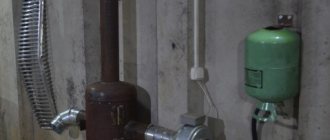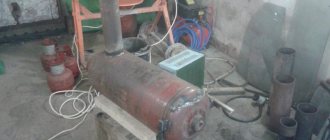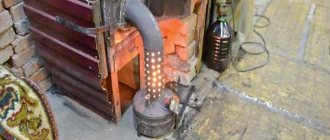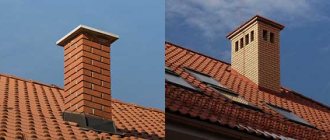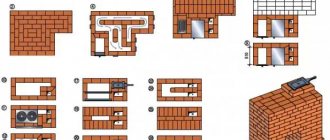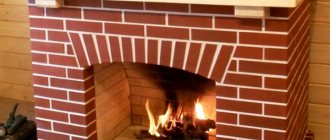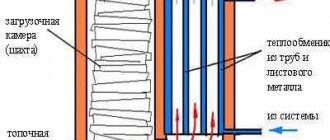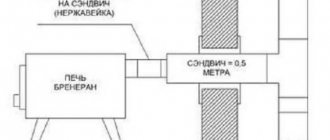In many Russian houses, the stove is the only source of heat, and in others it is an indispensable element of decor. The stove is a symbol of the true Russian spirit, hospitality, and comfort. If you still have a stove in your house, but it has not looked aesthetically pleasing for a long time, then you should not rush to dismantle it. The stove can be restored to an attractive appearance using inexpensive materials. One way is plastering. In this article we will take a closer look at how and with what to plaster a stove.
With the help of plaster, the stove can be brought into proper shape
Decorative design
The versatility of plaster makes it very flexible when it comes to decorative work. Since ancient times, stoves have been decorated with paintings, which can still be done by covering the walls with whitewash, as well as using water-based paints. Moreover, a damp, unbleached coating is an excellent opportunity to decorate the interior with frescoes.
Many types of decorative plaster can imitate noble stone chips. Special tools or the use of improvised means in the form of brushes, washcloths and even plastic bags will allow you to create a unique surface texture for every taste.
In addition, plaster goes well with decorative tiles, from which you can lay out interesting patterns, and, if desired, mosaics. Also, the presence of corner elements will make the creative process a little easier, and the appearance of the stove much more impressive.
Mixture preparation technology
The plaster mixture should be creamy and thick, but not too thick. The best way to mix plaster is with a drill with a mixer attachment.
Before plastering a brick stove, you should prepare the component materials. The clay needs to be soaked for a day in a large container so that it is well saturated with water and swells.
READ Is it possible to tint wall putty?
River sand (preferably) should be used. Before work, it must be sifted to avoid shells and other unnecessary inclusions. It is advisable that the sand be dry - this is necessary for the accuracy of the proportions of the plaster mortar with which you are going to cover the stove.
Cement is usually used grade M400. The higher the grade, the stronger the cement. This material begins to harden after 15 minutes, and setting is completed after 12 hours. The final strength of the cement layer applied to the surface of the furnaces is achieved after a month.
Lime is an excellent plasticizer for solutions. Its astringent properties ensure good adhesion to brick surfaces. However, the lime-based mixture hardens rather slowly - this fact should be taken into account when you are going to plaster the stove.
Before the solution hardens, the wall surface must be treated with a special grater covered with felt.
The plaster must be applied to a warm stove; to do this, before finishing work begins, the stove should be heated so that the mortar in the joints between the bricks heats up and dries. Then the stove will not shrink, and after plastering work the outer layer will not burst. This nuance is known to all stove makers.
It is also important to prepare professional plastering tools:
- trowels;
- spatulas;
- rules;
- brushes
In order for the solution to be of high quality, it is necessary to use a drill with a special mixing attachment as a stirring tool. This will prevent the formation of lumps in the solution, make it homogeneous, which is very important for the quality of the surface of the plastered layer on the stove, and will save your effort.
Whatever the solution, do not forget about using special bases for plaster - the mixture must be applied to a metal mesh (large mesh) previously installed on the stove. This technique will strengthen the plaster layer and give it strength in conditions of constant extreme temperature fluctuations. In some cases, stove makers use burlap for stoves as a reinforcing layer. Before plastering the stove , this material is glued onto the mortar to the outer surface so that there is no air gap. This method very effectively improves the performance characteristics of the outer layer of the furnace.
Stage 3: plastering the stove
Plastering a stove with your own hands.
Plastering stoves is done in a special way. There is a technology here that must be adhered to. So, you need to start with the first layer, which is called spray. Here the solution is taken and applied to the hot walls of the oven. Its thickness should not be more than 7 mm. Be sure to level the plaster layer with a spatula to get a smooth surface without any defects. In this case, it is necessary to use a more liquid solution for spraying. Then you will need to prepare a new one, but with a thick consistency. It must be applied when the first layer has dried a little. Its thickness should be approximately 5-6 mm. After this, you need to leave the oven for several hours so that the plaster dries a little.
Next, take a grater and grout the surface with it. Here you can use plastic or metal equipment. You will need to take a brush in the other hand; if necessary, you will need to moisten it in water, and then moisten with it those areas of the plaster that have dried out too much. During this work, it is necessary to achieve the most even surface possible. If any defects are found on it, for example, cracks or potholes, then you need to prepare a little solution and cover it with it. As soon as it dries, it will need to be rubbed down.
Then you need to do the finishing plaster. Here you need to take a different solution. It must be prepared from the following ingredients: lime whitewash, water, salt. The first step is to dilute the salt. Take 100 g of salt and 1 liter of water. Then the finished mixture is poured into whitewash (10 l). All this is thoroughly mixed and, if necessary, additionally diluted with water. After this, the solution is directly applied to the surface of the oven. It will be enough to cover everything in one layer to avoid further cracking of the finished coating. This completes the plastering of the stove with your own hands. You can enjoy its attractive appearance.
Useful tips from professionals
When making mortars, be sure to monitor the proportion of sand; if it is exceeded, the plaster will lose its elasticity.
It is necessary to carry out external finishing of the stove only after the brickwork has become completely solid, otherwise cracks will appear on the plastered surface.
To get the highest quality solution, be sure to sift the sand before preparing it and soak the clay in water for a day. Thanks to this, the plaster will be very durable, and in the end there will be no need to carry out finishing work again.
After plastering is completed, do not forget to hang decorative elements on the stove.
If you decide not to plaster the stove
If you decide not to plaster the surface of the stove, you will need to decorate the brickwork. And in this case, facing bricks may be the best option. The best alternative for external cladding of the walls of a structure are bricks with a flat and smooth surface. In this case, the masonry should be done quite carefully, and the seams will need to be unstitched.
For decorative jointing between rows of bricks, a special concave tool is used, and ordinary mortar is used. As an additional decorative element, the corners of the stove are edged, cutting them diagonally and thereby giving elegance to the structure. The same operations can be carried out before plastering the stove, during its construction.
THIS IS IMPORTANT: when doing colored jointing, bricks are selected based on the uniformity of their color. The seams on the front surface of the stove are left unfilled to a depth of 1 cm. The completed masonry is wiped with a damp cloth and sanded with a piece of brick. At the same time, all potholes, protrusions and chips are smoothed out.
Rub a mixture of white cement combined with asbestos flour and adding water into the seams with your hand, while wearing rubber gloves. The aesthetics of decorative masonry is affected by the uniformity and straightness of the width of the seams, therefore, when jointing, rules are used. First fill vertical seams, then horizontal ones. By adding various pigments to the solution, you can get a pattern of different colors.
Choosing the composition of the plaster
The question of how to plaster brick stove walls is the most important one when planning such an event. It should be said right away that the usual cement-sand mortar used for plastering the walls of a building is not suitable for stoves. It will simply crack in a very short time. For plaster, you can use a ready-made mixture intended specifically for this purpose, or prepare it yourself, but according to a special recipe.
To solve the question of what to plaster with, simple 2-3-component mixtures and complex compositions with the addition of various ingredients (fiberglass, asbestos, salts, plasticizers, etc.) can be used. The composition of the mortar also depends on the type of brick used for the construction of the stoves (fireclay, red brick, silicate varieties, etc.). Certain components added to the plaster increase its adhesion to the material.
If you decide to use ready-made materials, then you need to purchase a stove or fireplace plaster mixture. All the necessary ingredients have already been added to it, and preparation for application consists of diluting it with water in the proportion specified in the instructions. When using them, one caveat should be taken into account: their long-term storage is undesirable, since atmospheric moisture can lead to premature hardening of the mixture in the form of poorly soluble lumps.
Most often, homemade solutions for plastering stoves are prepared of the following types:
- clay;
- lime-clay;
- calcareous-sandy-clayey,
- lime-gypsum;
- cement-sand-clay.
The practice of furnace construction shows that it is precisely such compositions that are least susceptible to cracking when heated. Other additives are also introduced to improve properties.
When preparing the solution, it is important to choose the correct proportions of ingredients. The precisely selected composition allows you to easily and evenly apply a thin layer to the stove wall. In particular, a certain consistency of the composition is used as grout
The viscosity of the solution is regulated by the proportions of water, plasticity largely depends on the amount of sand, and the more of it, the less elasticity of the mass
In particular, a certain consistency of the composition is used as grout. The viscosity of the solution is regulated by the proportions of water, the plasticity largely depends on the amount of sand, and the more sand there is, the less elasticity of the mass.
Types of building materials
Today there are several compositions for lining the furnace. Let's look at the types and their features in the table.
| Types of building materials | Peculiarities |
| · Simple clay | low price, ease of manufacture, long drying. |
| Lime-gypsum | availability, short drying time, plasticity, difficulty of preparation. |
| · A mixture of cement, clay, sand | affordable price, long drying time. |
| · Lime-clay sand | difficult to prepare, high strength. |
Finding the right mixture for plastering stoves is quite difficult. Several criteria should be taken into account. The first is the purpose of the room. The stove can be placed in a bathhouse, in the kitchen, in the living room, or in the bedroom. Each type of room has its own parameters. The second is the humidity in the room. Not all of the solutions listed can reliably withstand high humidity. If this parameter is increased, it is better to give preference to more durable and expensive mixtures. The third criterion is finishing. After plastering, the stove can be whitewashed, painted, or tiled. The type of plaster required depends on the type of finishing.
The final result will depend on the quality of materials
How to plaster a stove - step by step diagram
Step 1: Heat the stove
Before preparing the solution for plastering the stove, heat it thoroughly so that it crackles where it should and warms up the walls. This rule cannot be broken even in the summer, despite the heat.
Step 2: Prepare the surface
Carefully go over the surface of the oven with a broom and brush to remove accumulated dust and remaining installation solution. To improve adhesion, it is better to clean and slightly deepen the cracks in the brickwork, but not more than half a centimeter.
Step 4: Reinforcement
If you decide to use burlap for reinforcement, this step is for you! The fabric, pre-cut into the required pieces, should be soaked in a liquid clay-sand solution and glued to the stove from top to bottom, just like wallpaper is glued. You can combine the pieces end-to-end, but it is better to overlap by at least 5 cm.
Step 5: Apply plaster
Remember that the thickness of each layer of plaster should be no more than 5 mm, and the total thickness of the facing layer should not be more than 1 cm. The solution must be applied from top to bottom, in an even layer, so that the facing dries evenly. As soon as the plaster has set well, it should be rubbed with a wooden float using circular movements. If the composition has hardened too much, moisten it with water. At the end of applying the plaster, people used to smooth it out with a rag soaked in a liquid solution of the same composition.
After completing the process, do not rush to heat the stove; let the layer of plaster dry completely. If cracks form during drying, they should be slightly widened with an ordinary knife, moistened with water and rubbed with the same solution. If over time you notice new cracks on the surface of the stove, analyze your actions - the stove may peel off and crack due to shrinkage, excessive layer thickness, or improper ligation of rows of bricks. In addition, cracks can also appear due to overheating.
How to mix clay composition?
Given the property of gypsum to set quickly, a small volume of the composition should be mixed. The preparation of the next portion should be carried out after using the previous one. The amount of sand in the solution can be changed depending on the fat content of the clay used.
Sufficiently fatty clay and sand are mixed in a ratio of 1:3 (4), respectively. To determine the exact ratio, the mixture should be applied to a small area to be treated. A dried, plastered fireplace may be covered with cracks, so sand in the required amount must be added to the plastering mixture in advance.
The solution can only be prepared from slaked lime. Fiberglass or asbestos is added to the mixture in a crushed state, which increases its strength. The gypsum-based oven plaster solution begins to harden quite quickly, so it can only be mixed in small quantities. After this, the composition should be immediately applied to the surface of the brick fireplace or stove.
READ What is the difference between tile adhesive and cement?
A cement mixture diluted in water is suitable for use within 50-60 minutes after its creation. The clay-based plaster solution should be stored in an airtight container. To slak the lime, pour it into a metal container (no more than 50% of the volume). Then the composition should be filled with water (no more than 60% of the volume). This must be done outside.
After 24 hours, the solution prepared by yourself should cool, then it is drained. The remaining pulp is ground through a coarse sieve, which allows you to sift out undissolved pieces. Clay for plastering a brick oven, after cleaning from contamination, should be transferred to water and left for several days. Then the soaked clay slurry should be passed through a filter, which is a coarse sieve, to remove any remaining debris from the composition.
The sand will need to be sifted and mixed with the clay. Next, fiberglass should be added to the solution. Then you need to thoroughly knead the prepared mass with an electric drill or a hammer drill with an attachment. The composition must acquire plasticity, homogeneity, and there should not be any lumps with solid particles.
Is it possible to plaster with Rotband?
Experts answer this question categorically - no. Such protection will quickly turn yellow and crack. The basis of this plaster is gypsum, which goes into a semi-aqueous state when the temperature reaches 1300. Such a layer will simply fall off the wall.
Therefore, it is better to use a proven method of preparing a solution from clay and sand, even if it takes several days to prepare it, than to end up with cracked walls.
In general, the most worthy option is to line the stove with ceramic tiles, which will serve for a long time and reliably. The main thing is to choose a good glue or solution and do the job well.
But it all depends on the choice of the home master
It is important for us to answer the main question of the article - what mortar should I use to plaster the stove? The TOP 10 mixtures from leading manufacturers of heat-resistant plaster will help you solve the problem of choice
How to plaster a chimney?
The chimney also needs lining. However, standard cladding is not suitable for it. It is necessary to find a material with high heat resistance. When choosing a mixture, you should also pay attention to environmental friendliness. When heated, no harmful substances should be released into the air. It is not worth saving on purchasing such a mixture.
For plastering pipes, it is worth selecting mixtures with increased heat resistance
If there are no financial opportunities, then the solution can be made on your own. To do this, mix one part clay, two parts sand, one part cement, and 0.1 parts asbestos. The pipe must be reinforced before applying the mixture. A budget option for strengthening is burlap. If a reinforcing mesh is used, it must be secured with self-tapping screws. The use of plastic dowels for this is strictly prohibited. They will melt from high temperature. In other nuances, the process of applying the solution to the pipe is identical to the process of plastering the stove itself.
Mantel
If facing work is planned after masonry, it is necessary to wait until the structure has completely dried, and only then begin to transform it.
Final work - finishing the erected fireplace
- The first thing they do when starting this process is to apply a special plaster to the masonry, perfectly leveling the walls. When they dry, mark them and only then begin cladding.
- Surface finishing starts from the corners. If possible, it is better to purchase special corner tiles for these areas, which will make the work easier and faster. In addition to marking on the planes of the fireplace walls, for the evenness of the rows and maintaining the thickness of the seams between brick-shaped tiles, special calibration devices are used in the form of crosses or tubes of the required thickness.
- A special adhesive is used to lay the tiles. It is applied in such a way that after pressing the tile it does not protrude on the sides.
- When the glue dries, the seams are sealed with a special mixture intended for this (heat-resistant fugue). This must be done very carefully, trying not to get the solution on the surface of the tile. If this happens, it should be wiped off immediately with a soft cloth.
For greater clarity, a video about building a fireplace with your own hands
This is not to say that folding a fireplace is completely simple, and a beginner will not encounter difficulties during the process. But with a strong desire and a detailed ordering scheme, this can be done. Cladding a structure is a more creative work, after which the building will be transformed and acquire its own “face.” This is what makes it interesting - after finishing laying the tiles, you can admire your work of art.
Required tools and materials
To plaster the stove, you need to prepare the tools.
- Metal scissors.
- An ordinary hammer.
- Spatulas of various sizes.
- Coarse sandpaper.
- Plumb.
- Building level.
- Reinforcing mesh.
- Plaster.
Before you start work, you should prepare the necessary tools
Process Features
So, when you have decided on the choice of plaster, and the necessary tools are already at the ready, all that remains is to start creating. However, in order to properly plaster the stove, you need to follow a certain technology and sequence of processing steps.
Surface preparation
Preparatory work is an important process that ensures the quality and durability of plastering. So that all your work does not turn out to be in vain, first of all, you need to perform the following actions:
- Remove old layers of cladding using a hammer and chisel, and then clean the surface of dirt and remaining substances with a brush.
- If the stove is new, you should also clean the masonry.
- Deepen all seams by 0.5–1 cm and remove dust from them.
- Prime the walls, including the seams.
It is very important not to start cladding a structure if it has just been built. You need to wait at least 3 months for the stove to “settle” and for the materials from which it consists to adapt to operating conditions
Preparing the mixture
The solution must be prepared after all the preparatory measures have been completed, otherwise the plaster may harden and become unusable.
Before mixing all the ingredients, the sand must be sifted and cleaned of foreign impurities. The same applies to clay - it is crushed and all debris in the form of particles of rocks and plants is removed. Next, the clay is soaked in water until the liquid covers it by 10–15 cm. On average, this process takes 2–3 days. When the base is ready, it is combined with the remaining components and stirred with a mixer. In some cases, it is permissible to add water, since the consistency of the finished solution should be similar to sour cream.
Warp finishing
Sometimes old age, damage or unscrupulous work of builders can cause distortions in the walls of the stove. You can fix this this way:
- focusing on the building level, set up beacons for alignment;
- heat the stove so that it is warm;
- moisten the slanting wall with a roller or brush;
- the surface is primed and left to dry;
- the first layer of plaster is applied using the “spray” method so that the mixture covers all the seams;
- after the first layer has dried, apply the second - it should protrude about 1 cm above the beacons. Start work from the bottom, leveling the rule every half meter of the layer;
- the wet solution is polished with grout;
- To level the corners, use a special corner spatula.
Application of mesh
The use of this mesh in cladding allows not only to level and hide surface defects, but also makes the plaster coating more uniform and durable. To plaster the stove, you need:
- install the mesh near the work surface at a distance of no more than 2.5 cm;
- “spray” apply the plaster and wait for it to harden;
- cover everything with the next leveling layer;
- rub out;
- decorate.
Light plaster
The need for such work usually arises if the stove has no obvious defects or distortions, but needs cosmetic repairs. Plaster it like this:
- guide elements are fixed on a previously prepared surface so that the coating is uniform;
- apply the solution from bottom to top with a wide spatula, which is immediately leveled using the rule;
- the corners of the structure are plastered with an angle spatula;
- the result is neatly erased.
Reinforcement and application of the mixture
You can start using the solution for plastering immediately after the walls of the oven have been heated and moistened with water using a brush or spray. Next, you can apply liquid clay. Reinforcement of the stove masonry is required in order to make the surface level. As a result, the stove plaster will be more durable.
When reinforcing ovens with your own hands, you must use clean burlap or reinforcing mesh. After special cutting, the burlap should be soaked for some time, immersed in a liquid clay solution. Then it should be distributed over the entire surface of the oven, onto which a dried layer of liquid clay is applied. The process has some similarities with wallpapering. The burlap should be laid from top to bottom and overlapped by 5 cm.
During operation of stoves reinforced with burlap, they should absolutely not be overheated. The reinforcing mesh must be secured using wire, which is laid on top of the cement mixture during the construction of the furnace. Using an electric drill, holes 50 mm deep should be made in the center of the bricks. You will need to insert a piece of wire into them, the length of which is 10 cm and the cross-section is 2.5-3.0 mm. The wire, cut into pieces, will need to be bent in the middle at an angle of 90°.
Inside the brick, the wire is reinforced with a cement mixture taken in small quantities. The ends of the wire should be staggered in 0.5 m increments from each other. After the cement mixture has hardened, a reinforcing mesh should be laid on top of the furnace, securing it to the free ends of the wire pieces.
After reinforcing the stove, you can plaster the surface in several layers. They should have a thickness of no more than 10-15 mm. Distribute your plaster solution evenly from top to bottom. When it sets but does not harden, it should be rubbed using a wooden float in a circular motion.
The mixture can be smoothed using a piece of rag soaked in the same solution, previously diluted with water. You can plaster the corners of the stove masonry using metal or wooden slats. They are installed using a level and then removed 10 minutes after the composition has been applied.
How to prepare a mixture for plastering stoves
The main materials for preparing stove plaster are clay and lime, the most popular solutions are lime-clay, lime-gypsum, cement-clay sand. To strengthen the plaster, some kind of reinforcing material is usually added to the solution: asbestos, fiberglass, straw, hemp. For some reason, salt is popular because it supposedly gives strength to plaster - but its usefulness has not been proven by anyone, so many craftsmen are skeptical about this method. On the other hand, the danger of asbestos to human health is widely known. In general, the question of the best reinforcing material still remains open.
Proportions for preparing complex solutions
Two methods of grouting plaster: circular and spreading.
In addition to clay, lime and cement, as well as gypsum, are used for finishing mortars of stove plaster.
Composition of the components of lime-gypsum mortar for brick stoves:
- Slaked lime - approximately 2 parts of the composition.
- Construction gypsum – 1 part of the composition.
- River sand – 1 part of the composition.
- Fiberglass or asbestos - at least 0.2 parts by volume.
The best SOLUTION FOR OVEN that does not cause cracks
When preparing such a mixture, it is important not to forget that gypsum is a material that hardens very quickly. Its setting begins after 5 minutes, and after 30 minutes it hardens almost completely. Take this point into account when you plaster the stove. This property of gypsum makes it an excellent additive for lime mortars, increasing their strength.
Composition of cement-clay-sand mortar:
- Portland cement - 1 part of the composition.
- Simple clay - 1 part of the composition.
- River sand - 2 parts of the composition.
- Asbestos - approximately 0.1 part of the composition.
Components of lime clay-sand mortar:
- Slaked lime – 1 part of the composition.
- River sand - 2 parts of the volume.
- Asbestos – at least 0.1 part of the composition.
The need to plaster the stove
A stove without external decoration has a number of negative qualities:
- The appearance of the structure cannot be called pleasant;
- Dust and various debris gradually accumulate in the gaps of the brickwork;
- The oven is very difficult to clean;
- A working stove emits a rather unpleasant odor;
- Through microcracks present in insufficiently high-quality masonry, smoke and carbon dioxide will leak into the room - a mixture quite harmful to human health.
Furnace finishing is used to level out these problems. The choice of finishing materials is purely individual - tiles, concrete coating or a suitable plaster mixture for the stove will be equally effective. However, preference is often given to plaster - it is much cheaper.
To decide how to plaster the stove in the house, you need to choose a finishing coating, which can be made of:
- Evenly laid ordinary brick;
- Facing brick.
Both materials, with proper quality of work and competently carried out jointing, make it possible to achieve a good appearance of the stove even without plaster. To enhance the visual quality of the structure, you can use a water-based varnish that creates the effect of wet stone. All this will prevent peeling of the plaster, which sometimes occurs over time.
The situation is much more complicated with an existing stove, especially if it is laid out crookedly and from uneven bricks. In this case, you will have to decide very carefully what is the best way to plaster the stove, because a mistake will certainly lead to cracking of the coating.
Before plastering a Russian stove, you need to understand the main reasons for peeling of the coating, which come down to the following list:
- Incorrect choice of thickness of masonry joints;
- Violations of the furnace order;
- Regular overheating of the oven.
To prevent these problems, you can use a reinforcing metal mesh with a cell size of no more than 1 centimeter. This mesh is laid on top of the stove and attached to it with 3 mm wire, which is inserted into each row of brickwork during the construction of the structure.
How to close the chimney?
Clay plaster will be a universal option due to its good heat resistance.
The part of the chimney located in the house can be covered with the same plaster composition as on the stove or fireplace. It can be tiled with ceramic tiles using cement plaster as a base. The proportions of cement and sand are 1:4. A fireplace chimney does not heat up as much as a stove chimney, because there is much less draft in it.
Lime-cement mortar is suitable for very hot surfaces. It is much stronger than clay, but it is more difficult to repair.
Chimney lining outside the house
The brick walls of the chimney are subject to large temperature changes, especially in winter. On one side there is hot smoke, on the other there is cold air. Because of this temperature difference, the brick breaks down over time. In addition, stove smoke contains oxides of sulfur and nitrogen. If the top of the chimney is cold, then water vapor on its walls condenses and, mixing with oxides, forms acids. This acidic condensate, as well as the temperature difference, destroys the brick pipe.
To prevent such a situation, part of the chimney outside the house must be insulated. To do this, a frame is installed, insulation is fixed on it, and everything is covered with tin sheets. Simply plastering the brickwork will not be enough.
chimney, insulated and covered with tin
Plastering a stove with clay - making the solution stronger!
Reinforcement of stove plaster is a separate topic for discussion. And again, traditional methods are by no means inferior to modern ones, the only question is what will be at hand during the plastering process or what will be easier to get. Reinforcement is carried out both by adding components to the solution itself, and with the help of foreign materials, for example, burlap. In the first case, people often added crushed flax fibers, straw, and horse manure. Today, asbestos is added to the clay solution - at least one tenth.
Burlap is still used by many craftsmen to reinforce stove plaster. This method has its pros and cons - such a stove cannot be overheated, but burlap is the simplest, environmentally friendly and affordable way to strengthen plaster. The burlap can be replaced with a thin mesh made of steel wire, the mesh size of which is no more than 1*1 cm. However, the fastening wire must be inserted into the masonry when constructing the stove. If you missed this point, you will have to use additives in the solution or burlap.
Briefly about the main thing
The problem of how to plaster a stove to prevent it from cracking can be solved in different ways, using various compositions based on cement, clay, gypsum, asbestos or lime.
The main requirements for leveling materials: elasticity, heat resistance, safety, mechanical strength and low thermal expansion.
The plastering itself is carried out in two ways: a reinforcing mesh made of steel or fiberglass is attached to the walls, or environmentally friendly fibers are added to the solution.
The consistency of the prepared mass depends on the purpose: roughing and grouting - liquid, leveling - like cottage cheese, for installing profiles - thick. At the same time, at each stage of work it is important to comply with the permissible standards regarding the layer. Enlargement causes improper drying, flaking and cracking.
Manufacturers and brands
| Brand of solution | Description | average price |
| Heat-resistant plaster for “Terracotta” stoves. Package weight 5 kg. |
Made from fireclay and kaolin clay, with the addition of binders and heat-resistant additives. The material is environmentally friendly and does not contain harmful substances. It is easy to apply and hardens quickly and has a high level of adhesion to surfaces. The solution retains its properties for 1 hour after mixing with water. Work is carried out from 5 0 to 35 0. The thickness of one layer is up to 10 mm.
From 140
Fireproof plaster from. Packaging 10 kg. Can be used for laying stoves. Made from refractory clays. Mineral and heat-resistant additives are added to the solution. The mixture hardens quickly and does not shrink the layer much. Easy to apply and remove from surfaces for possible repairs. Withstands high heating temperatures. Can be applied to old and new stoves. The plasticity of the mixture allows it to be smoothed and not destroyed during shrinkage of the seams and the foundation of the furnace. Fire resistance level – 600 0.
White thermal plaster "Plitonit SuperKamin Thermo". Packaging 25 kg.
Can be applied to fireclay or ceramic blocks. Thanks to its properties and easy application of an even layer, it can add attractiveness to the stove. Subsequent painting and finishing with all kinds of finishing elements, including tiles and ceramic tiles, is possible. Reinforcing elements have been added to the composition; they can be used for preliminary sealing of wide cracks and leveling of surfaces. The thickness of 1 layer is up to 30 mm while maintaining all properties. When sealing cracks, the layer can be made up to 50 mm.
Clay mortar for plastering the Kalina Master stove. Package weight 25 kg.
Portland cement has been added to the composition. This mixture has high strength, ductility and is able to withstand high temperatures when leveling surfaces in fireplaces. A layer of plaster increases heat transfer by 15%. Good adhesion makes the plaster resistant to mechanical stress.
265
Mixture for plastering fireplaces and stoves from. Bag weight – 20 kg. Made from red refractory clay with the addition of fire-resistant fillers and reinforcing heat-resistant glass fibers. This composition guarantees a high level of resistance to high temperatures while maintaining physical properties and adds strength to the composition layer. Produced in St. Petersburg. Can be used in the construction of fireplaces and exhaust pipes. It will last a long time if you follow the operating rules of the stoves and their protective layer.
Dry plaster for “Parad” stoves Made in Belarus. The base is cement with the addition of thermal insulation materials and fiberglass reinforcement. Such additives increase the heating temperature while maintaining the qualities and characteristics of strength, ductility and protects against cracking. Can be used for laying stoves and fireplaces.
Dry mixture for stoves and fireplaces "Real". 5 kg bag.
Can be used for laying ceramic facing bricks and constructing chimneys. The maximum heating level for the plaster layer is up to 1200 0 . Operating temperature – 500 0 with a layer thickness of up to 5 mm.
Ready-made mixtures for plastering RusGips stove No. 15. This mixture can be applied in slightly frosty conditions. It consists of a mineral mixture, which is obtained by intensive mixing of screened sand of a certain fraction with Portland cement and a complex of mineral additives that enhance the properties.
256
Fire-resistant plaster "ByProc TFS-170". Packaging 3 kg. Used for application to the internal and external surfaces of stoves and chimneys. Serves to level out uneven surfaces and subsequently apply an even protective layer of mortar. Operating temperature 500 0, while maintaining strength and elasticity.
Mixtures "ByProc" MMW-070. Package weight 3 kg. All data is the same as for the previous mixture. The only difference is the maximum temperature while maintaining high performance qualities. For this solution, it is 1100 0.
Can I use gypsum mixture?
For finishing brick stoves and fireplaces, ordinary gypsum mortars in their pure form should not be used - the lack of clay additives in their composition makes them unsuitable for use at elevated temperatures. A smooth surface after such plastering will very quickly become covered with cracks, and the stucco molding will become unusable.
If you have no experience in preparing solutions, the ideal option would be to purchase ready-made mixtures. In this case, you can be confident that the surface will be able to withstand high temperatures and temperature changes.
Conclusion
What is the best way to plaster a stove? No specialist can answer this question for you. Each stove maker has his own secrets and mortar compositions for plastering the surfaces of brick heaters at home.
You can make it from a mixture of clay and sand or knead a ready-made dry solution. This is a purely individual question. The main thing is to properly mix and apply a layer of plaster on the surface of the stoves.
Carrying out preparatory work
Before plastering the stove with your own hands, you need to prepare the room in which it is located. To do this, you should remove unnecessary items from it, and cover all furniture with unnecessary fabric. To cover the floor, walls and windows, you should use polyethylene, which will serve as protection from dirt and damage. The following types of materials will be required for work:
- Cement composition.
- Mixture to plaster the stove .
- Mesh for surface reinforcement (mesh size 10x10 mm).
- Lime (paint), which is water-based.
Before plastering the stove yourself, it is recommended to familiarize yourself with the technology of this process, and also take care in advance to prepare all the necessary tools and materials:
- electric drills for mixing with a mixer attachment;
- brushes or spray to moisten the surface;
- scissors for fabric and metal;
- containers for water and plaster;
- coarse sieve for sand and clay;
- mixture scoops;
- pliers or wire cutters;
- trowel or trowel;
- chisel or spatula;
- pliers;
- hammer;
- graters;
- vacuum cleaner;
- broom
Before applying a fresh layer of plaster to the old stove , it is necessary to completely clean its surface from worn-out composition, removing it with a chisel or spatula. To completely level the surface, you should use the grouting method using sandpaper. This will eliminate minor errors.
Surface preparation involves removing dust and small debris with a vacuum cleaner or broom. Then you can decide what to plaster the stove with and how to prepare the mixture with the optimal composition. For many home craftsmen, the preferred option is to prepare a regular clay solution. Depending on the preferences of the stove owner, soft, rough plaster or a mixture with a mother-of-pearl effect can be used. A fire-resistant mortar usually has a more complex composition than a simple mixture.
How to plaster a brick oven?
Unlined and unplastered brick stoves, as a rule, look rather unaesthetic. But the main drawback is that such stoves become a source of an unpleasant burning smell that appears during operation of the stoves due to dust accumulated in the seams of the brickwork. To avoid such an unpleasant phenomenon, it is recommended to cladding (with decorative ceramics, tiles, glazed tiles, etc.) or plastering the surface of the stove.
You can install the stove in the opening of an interior wall, in which case two rooms will be heated at once, or in the very center of the house.
This article describes in detail how to properly prepare a solution at home in order to properly plaster a brick stove, and also describes some technological techniques for applying a finishing layer to the stove.
Is it worth buying a ready-made mixture?
Undoubtedly, a factory-made mortar purchased on the construction market will be more reliable when plastering the stove. They are made from special components for interior decoration, which give the mixture many useful properties: it will be able to withstand higher temperature changes (up to +200...+250⁰C).
Plastering a stove with such a solution is practically no different from the process of applying a clay solution prepared by yourself. In addition, all factory mixtures have special instructions, which indicate the subtleties of working with the composition you have chosen.
Ready mix
The disadvantage of this approach is the price: the cost of a solution prepared by yourself will be slightly lower than the cost of a product purchased on the market.
